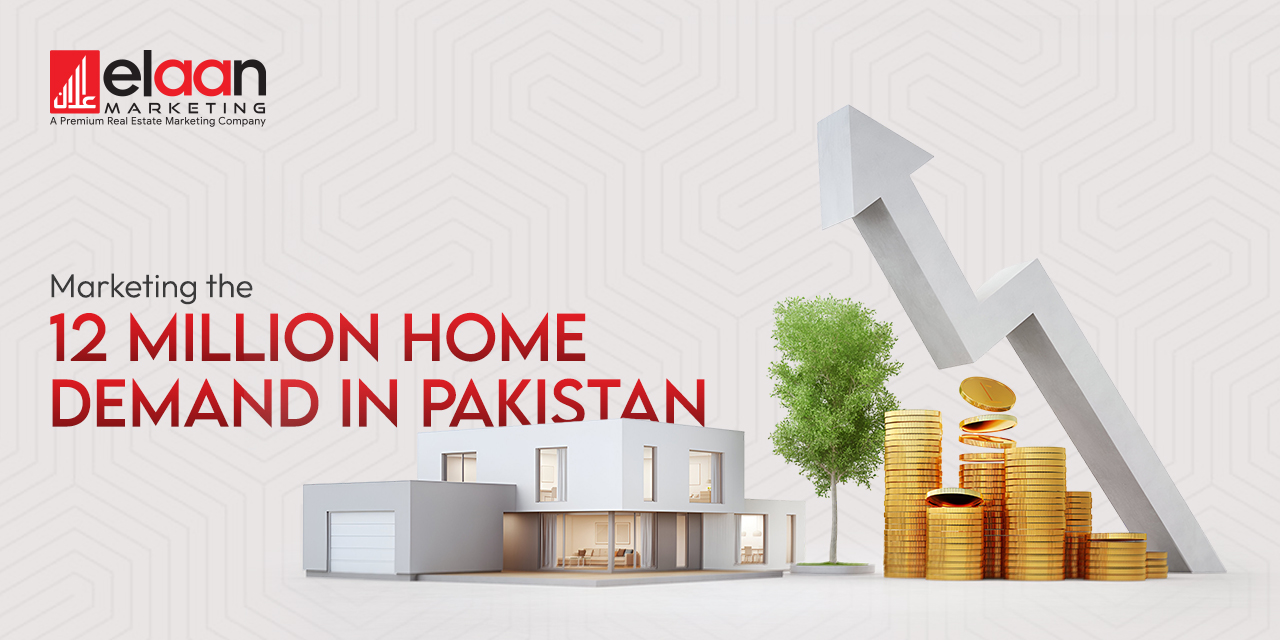marketing the 12 million home demand in Pakistan
Syeda Manal Tirmizi
June 30, 2025

Marketing the 12 Million Home Demand in Pakistan: The Wake-Up Call to the Builders and Investors in the Real Estate
Marketing the 12 million home demand in Pakistan is not just a necessity—it’s an opportunity. Pakistan is currently facing a massive housing shortage; today, we require more than 12 million homes, and this number continues to grow. However, where others see a crisis, intelligent developers and investors ought to recognize a once-in-a-generation opportunity. As cities become increasingly overcrowded, the demand for housing and office space is surging. When approached strategically, this demand could propel Pakistan’s real estate market into a new era of growth—unlocking profits, generating employment, and enabling urban evolution that supports long-term development.
A Housing Crisis in the Urban Markets
The urban population in Pakistan has increased due to the migration of millions of people to cities in search of work, education, and higher living standards. The infrastructure and real estate industry have been unable to keep up. Presently, middle- and low-wage earners are struggling to access modern, affordable housing. Marketing the 12 million home demand in Pakistan requires addressing this growing urban gap with practical, scalable solutions. This creates a significant opportunity to construct high-volume housing in key urban zones. From vertical apartments to intelligent housing complexes, everything is possible—provided it’s well-planned and backed by a strong strategy.
Student Housing in Pakistan: A $30 Billion Market
Student housing is one of the most underlooked sectors. There are high rates of young people in Pakistan, with more than 60 percent under 30 years old, and thousands of youth migrate to cities annually for university and job training. According to British firm One Homes, Pakistan’s student housing potential is valued at $30 billion. They have already taken steps to create the first student-living community in the country. Marketing the 12 million home demand in Pakistan must also include student accommodation—a market that remains largely untapped. Visionary developers with long-term plans can capitalize on this by building modern, secure, and profitable student housing in every major city.
Government Focus: A Clear Path Forward for Developers
The Pakistan government is currently interested in reviving the real estate industry in 2025. The Finance Minister Muhammad Aurangzeb has said he would seek to liberalize the rules and assist in the building sector by streamlining the policy. Important developments are:
• Lowering of the transaction taxes
• Examples of anticipated reduction of the 3% Federal Excise Duty (FED)
• The talk of amnesty plans on the inflow of investments
These policies are not mere symbols to show that the state is about to support builders. This is an opportunity that developers need to capitalize on because the conditions are good to start or expand projects.
Interest rates & Market Confidence
This led to the State Bank of Pakistan reducing the interest rate to 9 percent in early 2025, making borrowing more accessible and allowing the economy to flourish. This has brought renewed activity in the real estate sector, both in terms of property demand and construction.
Marketing the 12 million home demand in Pakistan has become more relevant than ever, as developers seize this opportunity to address the housing gap. The most credible investors—such as Zameen Developments, Eighteen, Imarat, and Chakor Ventures—are going full-fledged in launching projects across Islamabad, Lahore, and Rawalpindi, offering flexible plans with installment options as low as 1% per month. A good example is the MGC Jewel in Bahria Town Rawalpindi, a project endorsed by the Rawalpindi Development Authority (RDA).
Real Estate Role in the Development of the Nation
Pakistan’s real estate is not just a building industry—it’s the driving force behind over 40 dependent sectors. From cement and steel to glass, plumbing, furniture, and logistics, every home constructed contributes significantly to the national economy. Marketing the 12 million home demand in Pakistan plays a crucial role in activating this ecosystem, driving growth across all related industries. The idea of a $2 trillion market by 2025 is not mere speculation, but a real opportunity—made possible through intelligent urban planning, public-private collaboration, and transparent governance.
Flexible Financing and 3% Down Payments
The concept that allows becoming a homeowner. For most households and young professionals, purchasing a home is more of a dream than a reality—not due to lack of desire, but because initial costs are often too high. Smart developers are stepping in to change that. Marketing the 12 million home demand in Pakistan means creating real pathways to ownership by offering low down payments—as little as 3 percent—and flexible monthly payment options. These initiatives are opening the door for first-time buyers across the country.
This method does not only move units but establishes trust and makes renters homeowners. Applied on a bigger platform, it can really change the shape of the housing industry and bring more individuals to the ownership of homes over a long-term period.
The location: Hotspots in the city developers ought to target Location is everything in the case of real estate. In Pakistan, there are a few cities, exhibiting increasingly higher demand and speed of growth, therefore, they are a perfect setting to construct new housing and mixed-use projects: Rawalpindi & Islamabad Corridor -The RDA by nature has been developing at a rapid pace, especially in locations such as Bahria town and DHA. The Southern Belt of Lahore
Infrastructure: The Ring Road and Raiwind Road Zones are quickening in development. North Zone of Karachi – Following enhanced stability, the need for residential housing is again on the increase. Multan & Peshawar a series of new cities are becoming popular due to growing population and a low saturation rate. To developers, these areas are not only opportunities but also a ticket to long-term development and value.
Green Building is the Future of Real Estate
Green building will be the new real estate. Sustainability is not just an option—it’s the next big thing in the property market. Green building concept leaders are already gaining a competitive edge among developers. Marketing the 12 million home demand in Pakistan must also align with sustainable practices, as the future lies in eco-friendly, efficient living. Consider solar-powered houses, recycling-based plumbing systems, and intelligent, high-efficiency designs that reduce costs for consumers and attract investors focused on green energy solutions.
Frequently Asked Questions(FAQs)
How is the housing market in Pakistan such a big opportunity at this moment?
There is also a huge shortage of housing in Pakistan, with more than 12 million homes needed nationwide. The population in cities is becoming increasingly dense, and existing affordable housing options are falling short. Marketing the 12 million home demand in Pakistan is essential to bridging this gap—creating visibility for innovative, scalable solutions. This difference signals a massive opportunity for developers to step in and construct contemporary, intelligent, and livable housing across urban centers.
What kind of projects are developers supposed to concentrate on?
The largest opportunities are currently in middle-income housing, student housing, and commercial mixed-up projects. The need to have cheap apartments for families and safe core living areas as a necessity for the students is a deficiency in the city centers. Contractors concentrating on these areas are those that will remain ahead of the pack.
How is the government helping the real estate?
What makes student housing a smart opportunity?
Pakistan is a country with a young population, and a significantly large portion of them migrate to urban centers to attend college or training in a profession. And that is where the student housing opportunity of 30 billion is getting in. At this moment, there are not many student communities. This is a gap that can be addressed by the developers who should develop modern and secure places to live in by the students.
What are some of the high-growth development industries in Pakistan?
There are a number of areas that are experiencing fast growth: Rawalpindi- Islamabad: rich places such as Bahria Town, DHA, etc. Lahore: Ring road Areas and Southern areas. Karachi: The North and West region is reopening. Multan and Peshawar: Great demand and growing infrastructure.
What is the role of real estate in contributing to the rest of the economy?
The real estate sector drives more than 40 industries that deal with real estate activities, including cement, steel, furniture, and glass among others. Each new project will provide new jobs, small businesses, and money circulating in the economy. It is one of the most powerful forces of national development.
Why is it a once-in-a-generation opportunity for developers?
As the demand, policy support, low interest rates, and an expanding economy merge together, investing in 2025 will be the right decision. The fact is this: developers who act immediately stand an opportunity to shape the cities of Pakistan, as they also create profitable businesses that are prepared to face the future.
